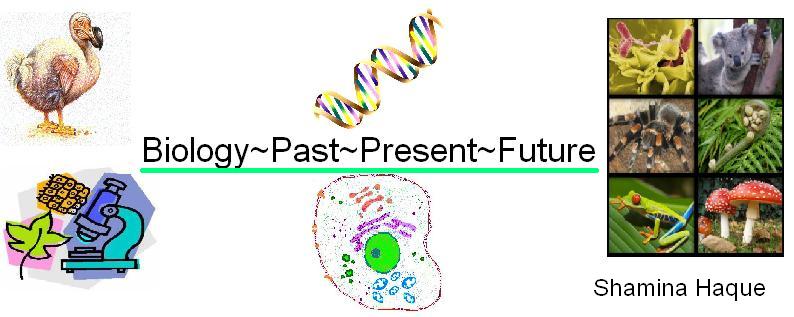Here's a link to the Science News slideshow "An Oceanic Endeavor: Census of Marine Life".
Click here to view this amazing compilation of the most fascinating marine creatures. Marine organisms are truly extraordinary and come in various odd and crazy shapes, colors and size. So much abundance of life in the ocean is often overlooked but there is literally a whole world out there with creatures like the sea cucumber, nemartean, and numerous others. The unique morphology and characteristics are unbelievable and remind us to conserve the beauty of these ocean entities by reducing our often destructive effects on the ocean with oil spills and other human activities.
Saturday, December 11, 2010
Friday, December 10, 2010
Double Helix Drama
In a recent article about the discovery of DNA, they discuss the fierce competition and jealousy that existed among contributors and discoverers such as Francis Crick, James Watson, Rosalind Franklin, Maurice Wilkins, and Linus Pauling. Letters surfacing after decades reveal that Crick disliked Franklin Franklin
Article Link: http://news.discovery.com/history/dna-discovery-drama-revealed-in-letters.html
Article Link: http://news.discovery.com/history/dna-discovery-drama-revealed-in-letters.html
Wednesday, December 8, 2010
The Dodo: Revealing a Past, Inspiring a Future
In biology we often study the living things around us but equally important are those organisms that are extinct and remain as examples that reveal the past and inspire the future. The dodo bird is an example of how fast a species can go extinct due to human activity. According to the American Museum Mauritius American Museum
 |
| Warner Bros. Gogo Dodo |
 |
| Museum of Natural History |
Tuesday, December 7, 2010
Stem Cell Research
Stem cell research is a controversial topic that has implications for the future of of mediccal practices and government policies. Here's a useful video for those who don't know what stem cells are and how they are used. Nice and simple video to show students in Biology class.
Here's a short clip from Family Guy regarding stem cell research. Very funny if you like or have watched Family Guy.
Here's a short clip from Family Guy regarding stem cell research. Very funny if you like or have watched Family Guy.
Monday, November 29, 2010
Patent for Genes?
I learned something new today. I really never knew you could get a patent for genes. Well not anymore, according to this article.
U.S. Says Genes Should Not Be Eligible for Patents By Andrew Pollack, New York Times
http://www.nytimes.com/2010/10/30/business/30drug.html?ref=genetic_engineering
U.S. Says Genes Should Not Be Eligible for Patents By Andrew Pollack, New York Times
http://www.nytimes.com/2010/10/30/business/30drug.html?ref=genetic_engineering
Monday, November 22, 2010
A Short History of Medicine
Found this to be very funny.
"I have a sore throat."
2000 BC : "Eat this root"
1200 AD : "That root is heathen, say this prayer."
1500 AD : "That prayer is superstition, drink this elixir."
1800 AD : "That elixir is snake oil, Take this pill."
1950 AD : "That pill is ineffective, Take this antibiotic."
2000 AD : "That antibiotic is artificial, here why dont you eat this root." — A short history of medecine.
"I have a sore throat."
2000 BC : "Eat this root"
1200 AD : "That root is heathen, say this prayer."
1500 AD : "That prayer is superstition, drink this elixir."
1800 AD : "That elixir is snake oil, Take this pill."
1950 AD : "That pill is ineffective, Take this antibiotic."
2000 AD : "That antibiotic is artificial, here why dont you eat this root." — A short history of medecine.
Sunday, November 21, 2010
Ancient Civilizations, Ancient Discoveries
After reading Science: Its History and Development Among the World's Cultures by Colin A. Ronan, I found some interesting discoveries of ancient civilizations.
For example the ancient Egyptians may have unintentionally applied science in very innovative ways despite their limited knowledge of science. The ancient Egyptians exhibited extensive biological knowledge by performing brain, dental surgery and embalming. To even attempt brain surgery is a surprising practice especially from a civilization that did not truly venture in to the scientific basis of things focusing rather on practical uses. Mummification is truly fascinating since it delays decomposition and gives us a well-preserved human body to study. The ancient Egyptians were able to explore anatomy of both humans and animals with their ability to identify, remove and preserve organs.
The ancient civilizations of China
Lastly the classification of species is also another discovery made by the ancient Babylonians. It is astonishing that they were able to identify species and attempt to classify them in systematic manner. This is truly an early example of classification which is significant aspect of biology. Of course this also stemmed from a practical reason since it is necessary to classify organisms when they sold different types of fish and other animals for consumption.

Mummy of Queen Hatshepsut, National Geographic

Silkworm webcastr.com
Subscribe to:
Posts (Atom)
